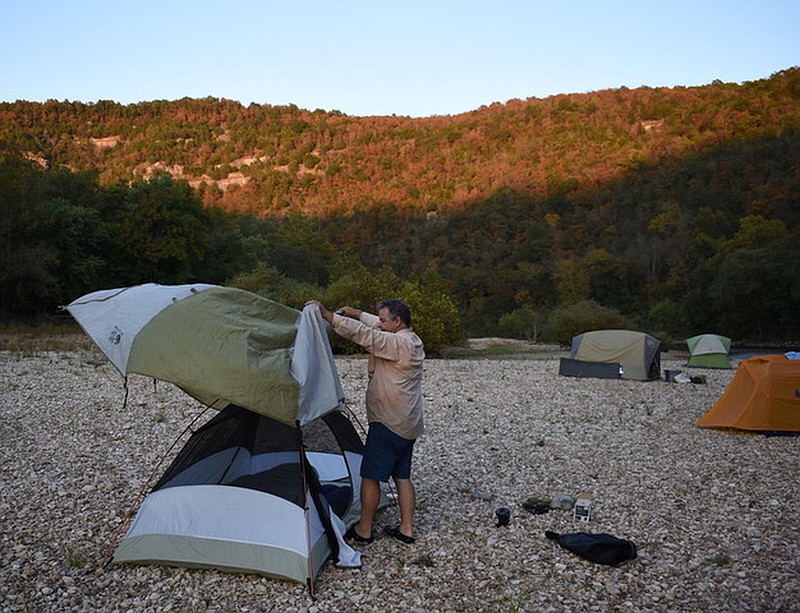Water lovers generally stay off the water in winter, but this is actually a prime time to enjoy the Natural State's lakes and streams.
Whitewater paddlers
The rains of late fall and winter swell some of our streams into some of America's finest whitewater destinations. The Big Piney and Cossatot rivers are two of the best.
Unknown outside the whitewater paddling community, the Cossatot River is the signature feature of Cossatot River State Park. Cossatot Falls flows through a boulder-studded canyon , dropping 33 feet in elevation in just one-third of a mile. High flow creates Class IV-V whitewater, which is suitable only for experts. One section, known as the "Skullcrusher," is aptly named, as is the perilous eddy known as "The Washing Machine."
When the water level is normal, the river's rapids are usually considered Class II-III whitewater.
According to the Cossatot River State Park website, late winter to early spring is peak whitewater paddling season.
Big Piney Creek is another revered whitewater destination. It flows about 80 miles through Newton, Johnson, and Pope counties, almost entirely within the Ozark National Forest.
Other destinations include Richland Creek. Because of its topography, it's a flash flood destination that produces excellent whitewater for a short period after a heavy rain. Whitewater enthusiasts pay close attention to the U.S. Geological Survey's water tables and weather reports. When it hits just right, a lot of people call in sick to work to hit it while it lasts. The same is true for the upper Buffalo River above Boxley Valley, known among whitewater enthusiasts as the Hailstone River.
A tamer destination for beginners is Whitewater Park at Malvern. It's a good place to learn basic whitewater paddling techniques and for intermediate level paddlers to practice.
Float fishing
A long tradition among a group of friends is to float fish the Caddo River in mid-winter. The Caddo River is usually full at this time, but it's gentle except at flood stage. Winter is also the best time to catch some of the biggest smallmouth bass of the year.
Our favorite section to float is from Caddo Gap to Glenwood. It has a lot of deep pools and riffles that contain multitudes of rocks and boulders. Fishing below the rapids is almost like being inside a fishing-themed pinball machine. The bells and lights make a tremendous spectacle as you bounce your lure off the bumpers, holes, saucers, spinners and kickers.
You can catch smallmouth bass, largemouth bass and Kentucky bass on any soft plastic lure that resembles a lizard or a crawfish. I prefer crawfish imitators that have a lot of red for winter fishing. For lizard imitators I prefer dark colors, like junebug or blue smoke. Small white crankbaits are often good. Surprisingly, winter is when I enjoy some of the best topwater fishing in streams.
While the Caddo River is fairly tame even in moderate conditions, it does have some technical rapids that can be tricky to navigate. To avoid a drenching, it's wise for whitewater novices to get out of the boat and guide it through rapids like the S-Turn. That's not a bad idea because the multiple runs below that rapid consistently produce the biggest smallmouths I have caught on the Caddo.
You should wear waders on a winter float fishing trip. Rusty Pruitt of Bryant neglected this detail during our first winter float on the Caddo in 2008. I drove the canoe into a giant standing wave, depositing about five gallons of icy water into Pruitt's lap.
The Caddo River between Caddo Gap and Amity is gentler. It's also more remote and less traveled. The fishing is outstanding.
Float camping
An overnight float fishing trip on the Buffalo National Rive in the winter is a sublime experience. The days are generally mild and sunny, making for a pleasant paddling conditions.
Put ashore on a suitable gravel bar an hour or so before sunset and gather a huge pile of wood for a campfire to keep you toasty for dinner and refreshments. There is no light pollution. Clear, crisp nights make the stars especially bright, and it's a great time to watch satellites streak across the sky.
I have experienced some of my finest meals on gravel bars. Few culinary joys rival a grilled ribeye, with corn on the cob and baked potatoes wrapped in aluminum foil cooked in the coals.
Wash it down with your beverage of choice. Pruitt likes boxed wine. Ed Kubler and I enjoy a fine bourbon. My favorite these days is Blade and Bow, introduced by Dr. Bobby McGehee, dean of graduate studies at the University of Arkansas for Medical Sciences.
Glass containers are prohibited on Arkansas waterways. You'll have to sip from cups made of foam or plastic, and your beverages must be in a metal flask or some other non-glass container.
For fishing, use the same lures as at the Caddo River. The fishing is usually best a few hours before sunset. One of my finest trips was a winter trip on Crooked Creek years ago with Pruitt. At dusk, big largemouth bass prowled a shoal, and I caught a succession of 2- and 3-pounders on an Excalibur chugger style topwater. That is the only time I have seen largemouths of that size and number on Crooked Creek, which is known for smallmouth bass.
For flatwater paddling and camping, Lake Ouachita is superb. Lash your gear on a kayak and explore deserted coves and bays. Camp on an island and try your luck at catching a walleye or two for breakfast
Arkansas has a lot of great places to enjoy winter water sports. To find them, the Arkansas Outdoor Atlas and Gazetteer is an excellent resource. Many exciting options are also featured at arkansasstateparks.com.
